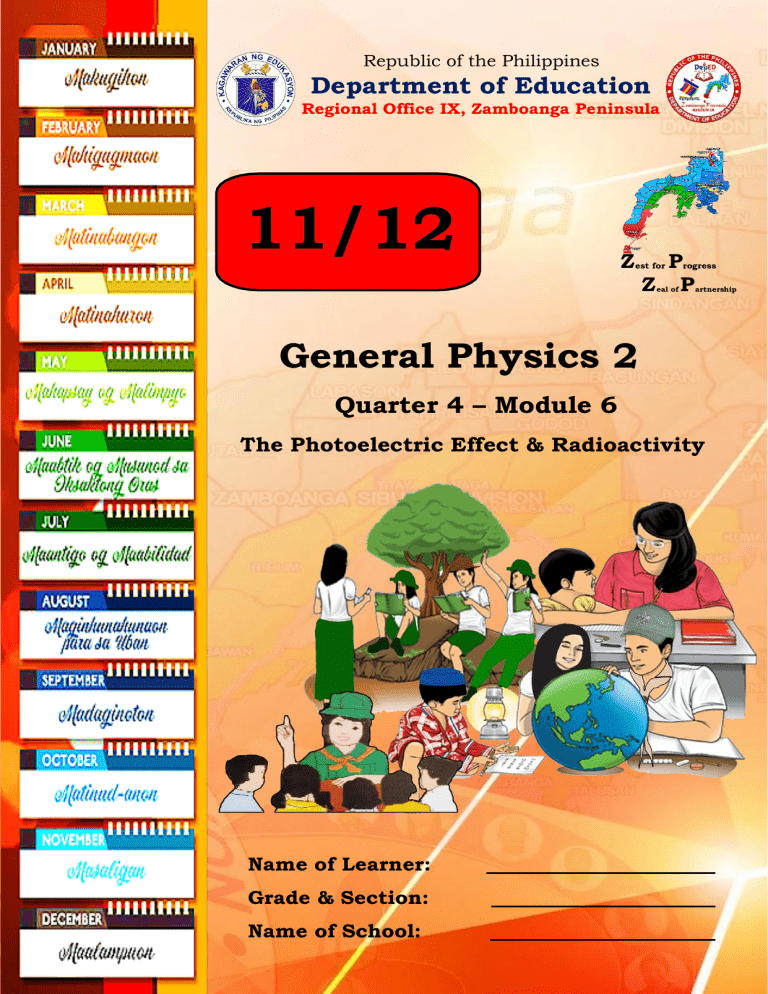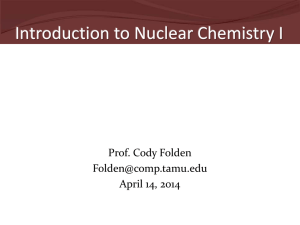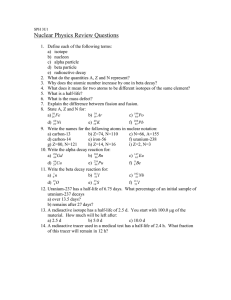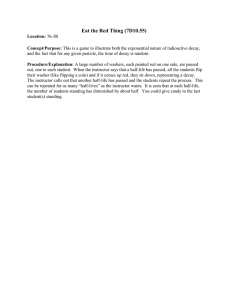Photoelectric Effect & Radioactivity: Physics Module
advertisement

Republic of the Philippines Department of Education Regional Office IX, Zamboanga Peninsula 11/12 Zest for Progress Z P eal of artnership General Physics 2 Quarter 4 – Module 6 The Photoelectric Effect & Radioactivity Name of Learner: Grade & Section: Name of School: Module 5 The Photoelectric Effect & Radioactivity What I Need to Know This module was developed to strengthen your knowledge about Photoelectric effect. It is designed to help you master in calculating the rate of decay of any isotopes using Half-Life. After comprehending this module, you are supposed to: 1. Explain the photoelectric effect using the idea of light quanta or photons. (STEM_GP12MPIVh-45) 2. Explain qualitatively the properties of atomic emission and absorption spectra using the concept of energy levels. (STEM_GP12MPIVh-46) 3. Calculating radioisotope activity using the concept of half-life. (STEM_GP12MPIVh-47) What’s In When you were in Grade 10, you were able to describe how electromagnetic wave were produced and propagated. All forms of electromagnetic waves that include light have a dual nature, that it considered as a wave and a particle. Let us recall some concepts on electromagnetic wave and light. ACTIVITY 1: DESCRIBING SOULMATE! Directions: Choose the correct term that best describe the statement and write your answer on the space provided before the number.(2pts each) Wave Light Electromagnetic wave Transverse Wavelength __________1.It is understood to be a transverse wave produced by a vibrating electric charge. __________2. Describe by Maxwell, as a propagating wave made up of electric and magnetic field. __________3.It is a wave in which the movement of the energy is perpendicular to the movement of the particle of the wave. __________4.Characteristic of EM, is the measurement of the distance between the successive crests or troughs of a wave. __________5. Moving oscillations, not carrying matter along. What’s New ACTIVITY 2A: PA EFFECT PA MORE! Directions: Write T if the statement is true, F if the statement is false and wirte the letter on the space provided before the number. _____1. When EM light is incident on a surface, electrons are ejected. _____2. Photoelectric effect demonstrates how electron are ejected. _____3. In order for the electron to be ejected the energy of the photon must be greater than to the amount of work. _____4. Ejected electron receive the energy carried by the photons that hits surface of the materials. _____5. Light must have a sufficiently long wavelength to provide energy large enough to eject electrons. ACTIVITY 2B: MATCH ME! Directions: Match column A with column B. Write the corresponding letter on the space provided before the number. Column A _____1. The amount of time in which half of any sample of identical nuclei will undergo decomposition. ______2. It is made up of protons and neutrons. ______3. A term, which means changes ejected electron into a nucleus of an element. ______4. It is dependent on the half-life of the substance. ______5. A force that holds nucleus together. Column B a. Nuclear Force b. Decay c. Half-life d. Radioactive decay e. Nucleus f. Electron What is it Photons or Light Quanta The radiation beam acts like a stream of energy particles, when electromagnetic radiation interacts with atoms and molecules. Each photon possesses an amount of energy dependent on the frequency (ƒ) or wavelength (λ) of the radiation in the beam. In calculating the photon energy it can be mathematically determined as photon energy = hƒ = hc/λ Where h = Planck s constant with the value of 6.626 x 10 34 Joules (J) ƒ = frequency λ = wavelength c = speed of light in a vacuum with the constant value of 3.0 x 108 m/s Photoelectric Effect A phenomenon when light is incident on a surface, electron are emitted or ejected. These electron gain energy from the photon that hit the surface of the materials. In order to eject the electron, light must have a sufficient short wavelength to provide large energy. Lastly the energy of the photon must be equal to the amount of work necessary to free an electron from the surface of the material. In many materials photoelectric effect can be observed but it can be easily observed in the metals. Figure 1. The emission of electrons from a Metal plate caused by light quanta Source: https://www.khanacademy.org/ Energy Levels, Atomic Emission, Atomic Absorption Energy levels are fixed distances from the nucleus of an atom where electrons may be found. Electrons at higher levels have more energy and it jump from a lower to the next higher energy level when it absorb this amount of energy. However this electron will move from higher energy level to a lower energy level when it emit or given off energy in a form of light. Take note that different atoms have different arrangement of electrons that is why, it also give off different colors. Figure 2. Absorption and Emission of electron Source: https://www.wikipedia.org/ Radioactive Decay and Half Life Radioactivity it is a property exhibited by certain types of emitting energy and subatomic particles spontaneously. Mostly unstable nucleus will decompose spontaneously, or known as decay, into a more stable configuration. This decomposition of an unstable nucleus will takes places in an specific ways by emitting certain particles or in the form of light. Radioactive Decay is the property of several naturally occurring elements that produced isotopes of the elements. Figure 3: Radioactive Decay Source: https://www.earth.com/ Types of radioactive decay 1. Alpha (α) particle decay - involves the ejection of two neutrons and two protons from the nucleus of a radioactive element. 2. Beta (β) particle - when a proton transforms into a neutron, emitting anti-electron or positron. 3. Gamma (γ) ray - is given to photons emitted from the nucleus. The spontaneous decay or radioactive decay can measured by its halflife. Half-life (t1/2) of an isotope in the time interval during which half of the atoms originally present disintegrate. The time interval required for a onehalf of the atomic nuclei of a radioactive sample to decay. The formula below shows the relationship between the initial number of nuclei (N) and the number of nuclei after the decay( ∆N) in a short time (∆t). ∆N = λN∆t Eq. I Where N = initial number of nuclei before the decay ∆N = number of nuclei after the decay ∆t = time of decay Λ = decay constant which is related to half life Then ΛT1/2 = 0.693 Rewrite equation I to derive the rate of decay ∆𝑁 =λN Eq. II ∆𝑡 where ∆𝑁 = rate of decay ∆𝑡 Example # 1 If carbon 14 contains a 1.00 x 1022 nuclei with a half-life of 5730 yr. How much nuclei will decay in a second? Step 1: Given N = 1.00 X 1022 Nuclei Half-life = 5730 yr. Step 2:Unknown ∆N = number of nuclei after the decay Step 3: Formula: 3.1. ΛT1/2 = 0.693 & 3.2. ∆N = λN∆t Step 4: Solution Solution 4.1: Calculate the number of second in a year and the decay constant 1.1. The number of second in a year = seconds x minutes x hour x year = 60 x 60 x 24 x 365 3.15 x 107 s/yr 1.2. Decay constant Λ = 0.693 /T1/2 = 0.693 (5730 yr)(3.15 x 10 7 s/yr) = 3.5 x 10 -8 s-1 Solution 4.2: Calculate the rate of decay ∆N /∆T = λN = (3.5 x 10 -8 s-1)(1.00 x 1022nuclei) = 4.2 x 10 6 nuclei/s Table 5.1 Half-life of some radioisotopes Radioactive substance Polonium-214 Oxygen-15 Sodium-24 Protactinium-238 Radon Iodine-131 Cobalt-60 Cesium-137 Carbon-14 Uranium-238 Half-life 0.00016s 2 minutes 15 hours 6.75 days 3.82 days 8 days 5.2 years 30 years 5730 years 4.5 billion years Half life is a measure of the stability of a radionuclide. The shorter the half-life, the more rapidly the nucleus decays and the more intense the emission. Hence, a short half-life is associated with a relatively unstable nucleus. What’s More Activity 3: Life Complete! Directions:Complete the given table and show the solution . Radioactive Half -life Initial Time of Decay substance Nuclei decay Constant(λ) (∆t) Oxygen-15 2 mins Radon 3.82 days Iodine-131 8 days Sodium-24 15 days 1.2 x 1012 3. 3.4 x 10 7. 1s 1min 10 5. hr 1hr 1. s-1 4. s-1 1.0x10-6s-1 8. s-1 Number of Nuclei after the decay (∆N) 2. 2.5x109 6. 1.5 x 108 Show your solution What I Have Learned Activity 4: Guess What! Direction: Write the correct answer that best describe by the statement. __________1. It is the property of several naturally occurring elements that produced isotopes of the elements. __________2. The half-life of a uranium-238. __________3. This are fixed distances from the nucleus of an atom where electron may be found. __________4. A phenomenon when light is incident on a surface, electron are emitted or ejected. __________5. It is a measure of the stability of a radionuclide. What I Can Do Activity 5: Solve Me! Direction: Solve the given Problem and show the solution needed. 1. Cobalt-60 has a half-life of 5.25 years. How many nuclei will remain after a second of decay? If the initial nuclei of Cobalt-60 is 2.3x1020. Step 1: What are the given in a problem? Step 2: What is the unknown in the problem? Step 3: What is the formula in finding the unknown in the given problem? Step 4: Show the solution Assessment Directions. Encircle the letter of the best answer. 1. Which of the following radioactive substances with half-life of 2 minutes? a. Cobalt -60 b. uranium-238 c. oxygen-15 d. sodium-24 2. What type of radioactive decay that proton transforms into a neutron, emitting anti-electron or positron? a. Alpha b. Beta c. Gamma d. all of the above 3. In order to eject electron light must have _______ wavelength. a. Short b. Long c. Wide d. Both a & b 4. When does electron moves from a lower energy level to higher energy level? a. Electrons emit energy. c. Electrons absorb energy b. Electrons emit and absorb energy d. Electrons given off an energy 5. What is the half-life of iodine-131? a.15 days b. 6.75 days c. 3.82 days d. 8 days 6. It is used to measure the spontaneous radioactive decay of an isotopes. a. Half-life b. Carbon dating c. radioactivity d. Energy Level 7. The electron will gain energy from_________ in order to eject from the surface of the materials. a. Proton b. Neutron c. Photon d. Positron 8. A type of radioactive decay in which the photon emitted from the nucleus of a atom. a. Beta b. Gamma c. Alpha d. all of the above 9. What will happen to the electron when it emits or given off an energy in a form of light? a. Electron will move to the higher energy level b. Electron will move to the lowest energy level c. Electron will stay on the same energy level d. Both a & b 10. A radiation beam acts like a stream of energy particles. a. Electron b. Photon c. Neutron d. Proton 11. It represent the decay constant in a formula. a. ∆N b. N c. λ d.∆t 12. What is the equivalent value of a plank constant? a. 6.626 x 10 14 Joules (J) c. 6.626 x 10 34 Joules (J) 24 b. 6.626 x 10 Joules (J) d. 6.626 x 10 44 Joules (J) 13. How many proton and neutron will be ejected during the alpha decay? a. 1 b. 2 c. 3 d. 4 14. It represent the number of nuclei after the decay. a. ∆N b. N c. λ d.∆t 15. Electron will be ejected if the energy of the photon is ________to the work necessary to free an electron. a. greater b. lesser c. equal d. all of the above Additional Activity Activity 6: More Practice! Directions: Solve the following problem and show all the solution 1. Cesium-137 has a half-life of 30 years. How many nuclei will remain after a minute? If the initial nuclei of Cesium-137 is 5.4 x 10 18. 2. Protactinium-238 has a half-life of 6.75 days. Suppose After a second of decay the total nuclei is equal to 1.5 x 10 12. How many nuclei is present in a protactinium-238 before a second of decay? Activity 2B 1. c 2. e 3. b 4. D 5. a Activity 5 1. Radioactive decay 2. 4.5 billion years 3. Energy level 4. Photoelectric effect 5. Half-life Activity 2A 1. T 2. T 3. F 4. T 5. F Activity 4 1. .0058 2. 6.96 x 10 9 3. 1.3 x 10 -4 4. 3.25 x 104 5. 19.25 hr 6. 3.4 x 104 7. 7.9 x 10 10 8. 5.34 x 10 -7 9. Activity 1 1. Light 2. Electromagnetic wave 3. Transverse 4. Wavelength 5. wave Answer Key- Gr12Q4W3 General Physics 2 References Books: Science 4 Teacher Guide, Page 115-120 Science Learning Guide Grade 8, Page 10 - 15 Electronic Resources: https://www.wikipedia.org/ https://www.earth.com/ Development Team Writer: Jonathan R. Linaza, T-III, ZSNHS Editors: Irmina C. Calibo, T-III, ZSNHS Reviewer: Mila P. Arao, EPS Illustrator: Layout Artist: Management Team: DANNY B. CORDOVA, EdD, CESO VI SDS MA. COLLEEN L. EMORICHA, EdD, CESE ASDS MARIA DIOSA Z. PERALTA CID Chief MA. MADELENE P. MITUDA, EdD EPS-LRMDS MILA P. ARAO, EPS-Science Region IX Hymn OUR EDEN LAND Here the trees and flowers bloom, Here the breezes never gently blow, Here the birds sing Region IX... merrily, And liberty forever people stays, Golden beams of sunrise and sunset, Are visions you’ll forget. Oh! That’s Hardworking abound, Every valley and dale Zamboangenos, Here the Badjaos Tagalogs, swam the seas, Bicolanos, Here the Samals live in Cebuanos, Ilocanos, peace, Subanens, Boholanos, Illongos, Here the Tausogs All of them are thrive so free, proud and true With the Yakans in Region IX our unity. Eden Land. Gallant men And Ladies fair, IX, our Linger with love and Region Eden Land. care,




